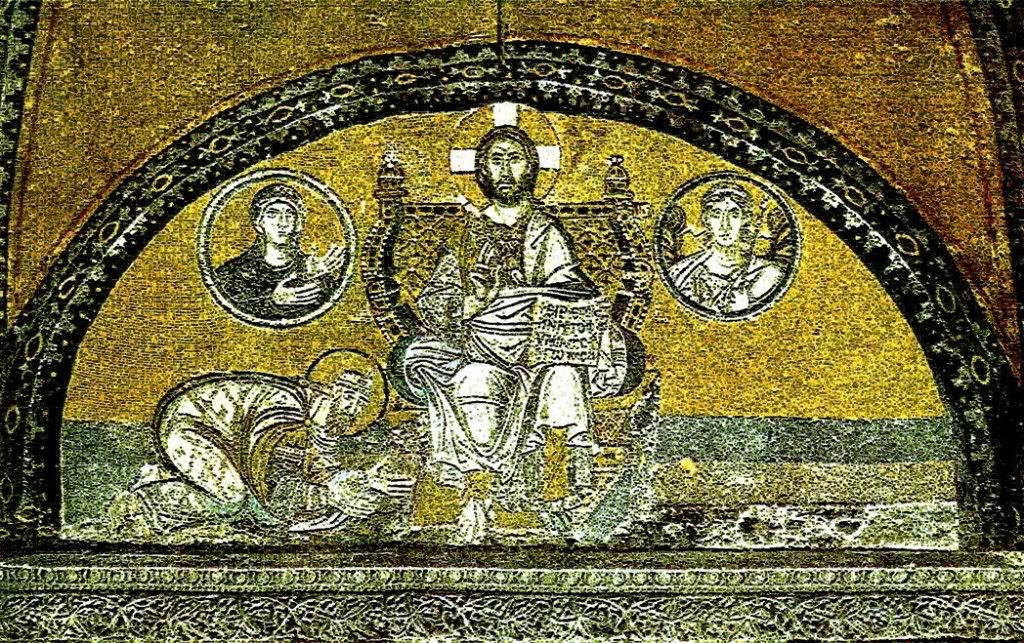The Emperor Leo VI, the Wise (886-912), prostrated before Christ. Mosaic of Hagia Sophia
Over the Imperial Gate from the narthex to the church Leo VI, the Wise (886-912), is thus shown prostrated at the feet of Christ with medallions of the Virgin and an Archangel above. The Archangel no doubt symbolizes the belief that the chuch of Hagia Sophia was built with divine aid while Angels watched.

Ο αυτοκράτορας Λέων Στ΄ ο Σοφός γονυπετής μπροστά στο Χριστό. Στα μετάλλια η Παναγία και ο αρχάγγελος Γαβριήλ. (9ος αιώνας)
Giving incorruptible Holy Sacrament to us in the communion after sacring was postulated by the Church Fathers. For instance in his Mt hom. 82 (83), 5 St. John Chrysostom speaks: «...let us approach this table and the nipple of the spiritual cup...like nursing children let us eagerly draw out the grace of the Spirit, for to share in the divinity of Christ is to be in communion also with the Father and the Holy Spirit, who share the same divine nature. So to receive the eucharist is to receive the Holy Spirit» (PG 58, 744 (= CPG § 4424)). In Ioh hom. 46 (47), 4: «From this table springs up a fountain that sends forth spiritual rivers... Many are the streams of that fountain which the Paraclete sends forth, and the Son is the mediator» (PG 59, 261-262 (= CPG § 4425)).
By ancient tradition only Emperor could enter the sanctuary to offer his gifts and receive communion as it was canonized by canon 69 of the Quinisext Council «in Trullo» in AD 691/2 (The Council in Trullo Revisited / eds.G. Nedungatt, M. Featherstone. (Kanonika 6). Rome, 1995. P. 151 = Mansi 11, 969). On Trullo and its canons, see: Nedungatt-Featherstone and V. Laurent. L’oeuvre canonique du Concile en Trullo (691-692), source primaire du droit de l’église orientale // Revue des études byzantines 23 (1965). Р. 7-41. On the imperial communion, see: R.F. Taft. The Byzantine Imperial Communion Ritual // Ritual and Art: Essays for Christopher Walter.ed. Pamela Armstrong. London, 2003; R.F. Taft . A History of the Liturgy of St. John Chrysostom. Vol. II: The Great Entrance. A History of the Transfer of Gifts and Other Preanaphoral Rites of the Liturgy of St. John Chrysostom (OCA 200). Rome, 1978. P. 26-31; F.J. Dölger. Kaiser Theodosius der Große und Bischof Ambrosius von Mailand in einer Auseinandersetzung zwischen Predikt und Meßliturgie // Antike und Christentum 1 (1929). P. 54-65.
In accord to the 10th-century De ceremoniis to hold the crown and chlamyde it were used liturgical tables during the imperial coronation and wedding rites (De cerimoniis I, 39 (30) - Le Livre des cérémonies de Constantin Porphyrogénète. Texte I-II. ed. A. Vogt. Paris, 1935, 1939). About the origins of these communion table (antimesion) one can see the anonymous 8/9th-century Narratio de S. Sophia §16, describing the sanctuary of Justinian’s Great Church, which says the Emperor «set up on the presbytery four silver tables (trapezas) on columns, and these, too, he gilded» (Scriptores originum Constantinopolitanarum. ed.T. Preger. (Bibliotheca Scriptorum Graecorum et Romanorum Teubneriana, Scriptores Graeci). Leipzig, 1901-1907. P. 94).
As described for the Hagia Sophia Christmas liturgy (Le Typicon de la Grande Église. Ms.Sainte-Croix n°. 40, Xe siècle. Introduction, texte critique, traduction et notes. ed. J. Mateos. 2 vols. (OCA 165-166). Rome, 1962-1963. Vol. I. P. 154-159) the Emperor was summoned to communion after the kiss of peace,
«The Emperor goes again to the metatorion, and at the time of the divine communion, the master of ceremonies signals the praepositus, and the praepositus [signals] the Emperor, and he goes out, preceded by the above-mentioned [officials], and when he is before the patriarch to communicate in the immaculate Body and Blood of Our Lord Jesus Christ, two porters hold a cloth spread out, and after receiving the precious gift in his hands, he kisses the patriarch and after descending the platform [of the communion antimension] and making the sign of the cross three times, he communicates in the Holy sacrament. Then he mounts the same platform again and the porters spread the cloth under him, and after receiving the eucharistic wine from the patriarch, he descends, and having prayed, both [the Emperor and the patriarch] bow to each other, then turning, he retires to the metatorion and dines with the patricians and dignitaries whom he will have invited» (De cerimoniis I, 32 (23) - Le Livre des cérémonies de Constantin Porphyrogénète. Texte I. ed. A. Vogt. Paris, 1935. P. 124).
To be continued...